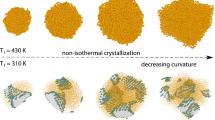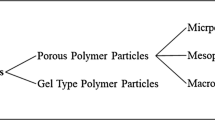Abstract
The crystallization behavior of polyethylene (PE) and polypropylene (PP), including the neat ones and the ones nucleated with the same nucleating agent (NA), was studied by DSC. It was found that the nucleating agent decelerated the PE nonisothermal crystallization process. NA did enhance the nucleating rates for both PE and PP, but the linear growth rate dominated the volumetric growth rate for PE, and the volumetric growth rate dominated the overall crystallization rate. That is why PE nucleated with NA had a slower overall crystallization rate than the neat one.
Similar content being viewed by others
References
Yash PK. Rheological mechanism and overview of nucleated crystallization kinetics. Macromolecules, 1993, 26: 3639–3643
Qiao J, Guo M, Wang L, Liu D, Zhang X, Yu L, Song W, Liu Y. Recent advances in polyolefin technology. Polym Chem, 2011, 2: 1611–1623
Huang Y, Chen G, Yao Z, Li H, Wu Y. Non-isothermal crystallization behavior of polypropylene with nucleating agents and nano-calcium carbonate. Eur Polym J, 2005, 41: 2753–2760
Kristiansen M, Werner M, Tervoort T. The binary system isotactic polypropylene/bis(3,4-dimethylbenzylidene)sorbitol: Phase behavior, nucleation, and optical proper-ties. Macromolecules, 2003, 36: 5150–5156
Bernland K, Tervoort T, Smith P. Phase behavior and optical- and mechanical properties of the binary system isotactic polypropylene and the nucleating/clarifying agent 1,2,3-trideoxy-4,6:5,7-bis-o-[(4-propylphenyl)methylene]-nonitol. Polymer, 2009, 50: 2460–2464
Mohmeyer N, Müller B, Behrendt N, Hillenbrand J, Klaiber M, Zhang X, Smith P, Altstädt V, Sessler G, Schmidt HW. Nucleation of isotactic polypropylene by tri-phenylamine-based trisamide derivatives and their influence on charge-storage properties. Polymer, 2004, 45: 6655–6663
Výchopňová J, Čermák R, Obadal M, Raab M, Verney V, Commereuc S. The role of specific nucleation in polypropylene photodegradation. Polym Degrad Stabil, 2007, 92: 1763–1768
Zhang P, Liu X, Li Y. Influence of β-nucleating agent on the mechanics and crystallization characteristics of polypropylene. Mat Sci Eng A, 2006, 434: 310–313
Smith TL, Masilamani D, Bui LK, Khanna YP, Bray RG, Hammond WB, Curran S, Belles JJ, Shari BC. The mechanism of action of sugar acetals as nucleating agents for polypropylene. Macromolecules, 1994, 27: 3147–3155
Hoffman K, Huber G, Mäder D. Nucleating and clarifying agents for polyolefins. Macromol Symp, 2001, 176: 83–91
Milliken unveils ‘first cost-effective’ PE nucleating agent. Add Poly, 2007, 9: 3–4
Dotson DL, Burkhart BM. Organic nucleating agents that impart very high impact resistance and other beneficial physical properties within polypropylene articles at very low effective amounts. US Patent, 2004/0132884 A1. 2004-7-8
Wolters WS, Lake KD. Compositions comprising metal salts of hexahydrophthalic acid and methods of employing such compositions in polyolefin resins. US Patent, 2008/004384 A1. 2008-1-3
Reyntens W, Horrocks M, Diederik G, Hanssen R. Polymer additive compositions and methods. US Patent, 2008/0139718 A1.2008-6-12
Hannsen R, Barker MB, Mehl N, Wolters WS, Berhardt SM, Radwanski AT. Polymer Compositions Comprising Nucleating or Clarifying Agents and Articles Made Using Such Compositions. US Patent, 7786203 B2. 7786203 B2. 2010-8-31
Avrami M. Kinetics of phase change. I. General theory. J Chem Phys, 1939, 7 (12): 1103–1112
Avrami M. Kinetics of phase change. II. Transformation-time for random distribution of nuclei. J Chem Phys. 1940, 8(2): 212–224
Avrami M. Kinetics of phase change. III. Granulation, phase change and microstructure. J Chem Phys. 1941, 9(2): 177–184
Jeziorny A. Parameters characterizing the kinetics of the non-isothermal crystallization of poly(ethylene terephthalate) determined by D.S.C. Polymer, 1978, 19: 1142–1144
Armistead JP, Hoffman JD. Direct evidence of regimes I, II, and III in linear polyethylene fractions as revealed by spherulite growth rates. Macromolecules, 2002, 35: 3895–3913
Xu J, Srinivas S, Marand H. Equilibrium melting temperature and undercooling dependence of the spherulitic growth rate of isotactic polypropylene. Macromolecules. 1998, 31: 8230–8242
Author information
Authors and Affiliations
Corresponding author
Rights and permissions
About this article
Cite this article
Jiang, H., Zhang, X. & Qiao, J. Different influences of nucleating agents on crystallization behavior of polyethylene and polypropylene. Sci. China Chem. 55, 1140–1147 (2012). https://doi.org/10.1007/s11426-012-4516-y
Received:
Accepted:
Published:
Issue Date:
DOI: https://doi.org/10.1007/s11426-012-4516-y




